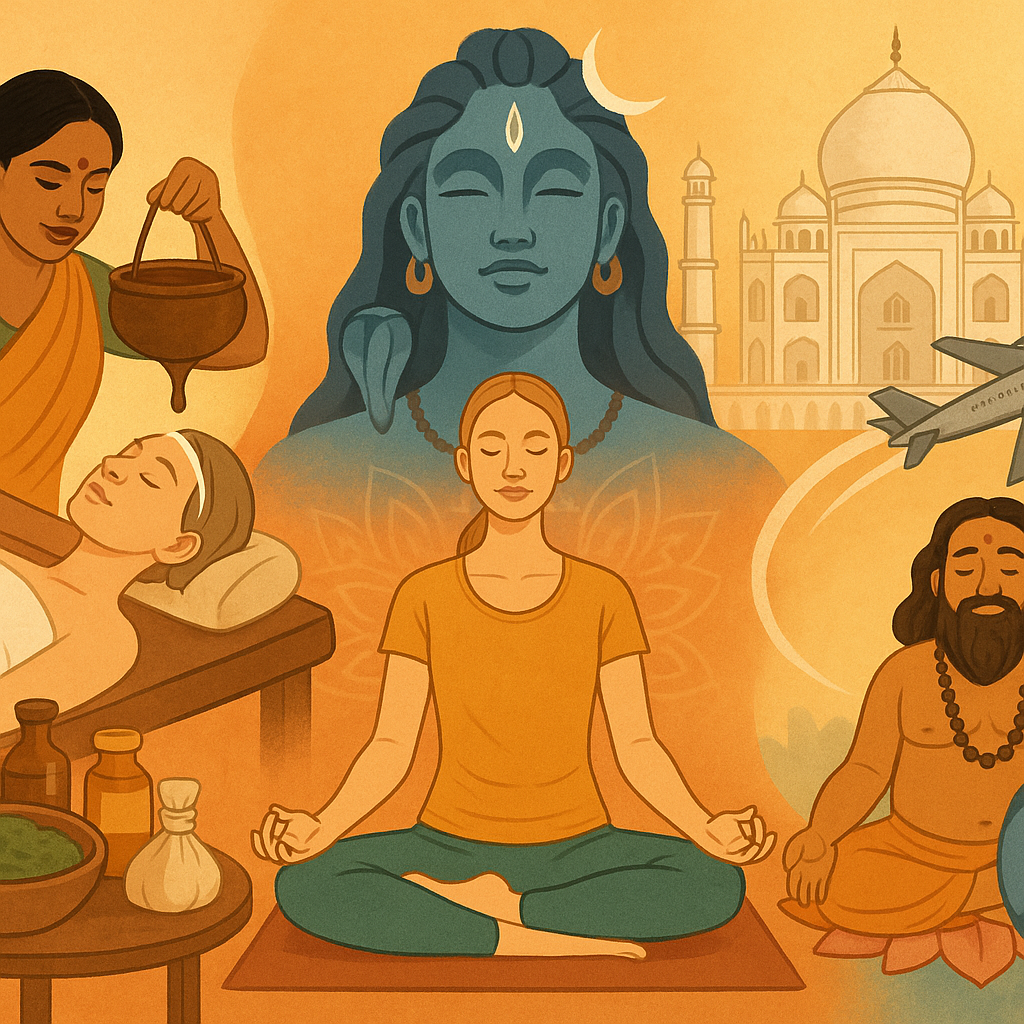Hinduism Abroad: Yoga, Ayurveda & Spiritual Exportation
In the last century, Hinduism has crossed oceans and continents, transforming from an ancient Indian way of life into a global spiritual influence. Today, millions of people around the world chant Sanskrit mantras, practice yoga at dawn, and consume Ayurvedic herbal teas — often without realizing that they are engaging with India’s deeply rooted spiritual heritage. The global spread of Hindu ideas has created what some call “soft spirituality” — a form of cultural export that blends wellness, philosophy, and faith. But how did Hinduism, once confined largely to the Indian subcontinent, become such a powerful global force?
The Journey of Ideas: From Vedas to the West
The seeds of Hinduism’s global journey were sown in the late 19th and early 20th centuries, when Indian thinkers began presenting their philosophies to Western audiences. The most iconic moment came in 1893, when Swami Vivekananda addressed the Parliament of the World’s Religions in Chicago. His message of universal brotherhood and tolerance resonated deeply with audiences weary of dogmatic religion. That speech marked the beginning of Hinduism’s global recognition as a philosophy rather than a proselytizing faith.
Later, teachers like Paramahansa Yogananda, who wrote Autobiography of a Yogi, and the Theosophical Society in the early 1900s helped introduce Hindu metaphysics, meditation, and yoga to the Western world. These early ambassadors presented Hinduism as a rational, experiential spirituality — not bound by ritual or creed, but open to seekers of all backgrounds.
Thus began the transformation of Hinduism from a regional tradition to a universal philosophy that spoke to the human search for peace, balance, and inner realization.
Yoga: The Universal Language of the Body and Spirit
Of all Hindu exports, none has had a greater global impact than Yoga. Rooted in the Yoga Sutras of Patanjali and embedded in the spiritual practices of Hinduism for thousands of years, yoga was originally designed to discipline the mind and prepare it for union with the divine. In the modern world, however, it has taken on multiple forms — physical, therapeutic, and spiritual.
From Hollywood studios to European wellness retreats, yoga has become a billion-dollar global industry. Yet, at its heart, it continues to carry echoes of its Hindu roots: the chanting of “Om,” the celebration of Surya Namaskar (sun salutations), and the concept of achieving moksha — liberation through self-control and awareness.
India’s declaration of International Yoga Day in 2015, endorsed by the United Nations, solidified yoga’s global status. Today, over 190 countries celebrate it annually, not as a religious ritual, but as a universal practice of health and harmony. This blending of sacred and secular is perhaps Hinduism’s most subtle form of diplomacy — spreading values of mindfulness and unity without conversion.
Ayurveda: Healing as a Sacred Science
Alongside yoga, Ayurveda — the ancient Indian system of holistic medicine — has gained international acclaim. Rooted in the Atharva Veda, Ayurveda sees health as a balance between body, mind, and spirit. Its core principle, “Swasthasya Swasthya Rakshanam” (to maintain the health of the healthy), aligns closely with modern preventive healthcare philosophies.
Today, Ayurvedic products, from turmeric supplements to herbal skincare, occupy shelves in global markets. Institutions like the Ayurvedic Institute in New Mexico and the European Institute of Vedic Studies testify to the growing curiosity toward this 5,000-year-old science. What distinguishes Ayurveda from modern medicine is its moral dimension — it treats healing as a spiritual act, not merely a physical repair.
In the West, where chronic stress and lifestyle diseases dominate, Ayurveda’s personalized approach — through doshas (body types), diet, and meditation — has become both a wellness trend and a philosophical guide to balance.
The Spiritual Export: From Gurus to Global Communities
Beyond practices like yoga and Ayurveda, the global spread of Hinduism owes much to its modern teachers and spiritual movements. Figures such as Sri Sri Ravi Shankar, Sadhguru Jaggi Vasudev, Maharishi Mahesh Yogi, and Swami Chinmayananda have built international communities that blend ancient wisdom with modern psychology and science.
Movements like the Art of Living, Chinmaya Mission, and ISKCON (the International Society for Krishna Consciousness) have established ashrams and centers across continents. These organizations attract not only the Indian diaspora but also Western seekers disenchanted with materialism. Through meditation retreats, Gita study groups, and cultural festivals, Hindu spirituality has found new life in global contexts.
Interestingly, many of these teachings emphasize universality — “Vasudhaiva Kutumbakam” (the world is one family) — reflecting Hinduism’s inclusive spirit. Rather than converting others, the tradition seeks to awaken the divine within all, regardless of religion or nationality.
Cultural Adaptation and Controversy
However, the global expansion of Hindu ideas has not been without challenges. The commercialization of yoga, often stripped of its spiritual roots, has sparked debates about cultural appropriation. Some critics argue that turning sacred practices into fitness routines or marketing tools dilutes their depth. Others see it as cultural exchange — a natural evolution that keeps traditions alive by adapting them to new audiences.
Ayurveda faces similar dilemmas: while its popularity grows, misinformation and unregulated products sometimes distort its authenticity. Yet, despite these challenges, the core message of balance, self-awareness, and harmony continues to resonate worldwide.
Hinduism’s Modern Mission
Hinduism’s success abroad lies in its adaptability. Unlike missionary religions, it spreads not by conversion but by inspiration. Its emphasis on personal experience over dogma allows people from diverse backgrounds to engage with it freely — whether through meditation, philosophy, or vegetarianism.
As climate change, stress, and inequality shape the global psyche, Hinduism’s timeless teachings — the unity of life (Ekam Sat Vipra Bahudha Vadanti), respect for nature, and the pursuit of inner peace — feel increasingly relevant. Yoga, Ayurveda, and meditation are no longer exotic imports; they have become universal languages of well-being.
From India to the World — and Back
The global journey of Hinduism is, in many ways, a circle. What began in India as an inward path of self-realization has returned from abroad as a reminder of its own worth. Western enthusiasm for yoga and Ayurveda has rekindled pride and innovation in India’s own traditions.
In the end, Hinduism abroad is neither mere export nor adaptation — it is a living dialogue between East and West, ancient and modern, body and spirit. As long as humanity seeks meaning beyond material success, the wisdom of Hinduism will continue to travel — not as a relic of the past, but as a radiant bridge to the future.
~Religion World Bureau









